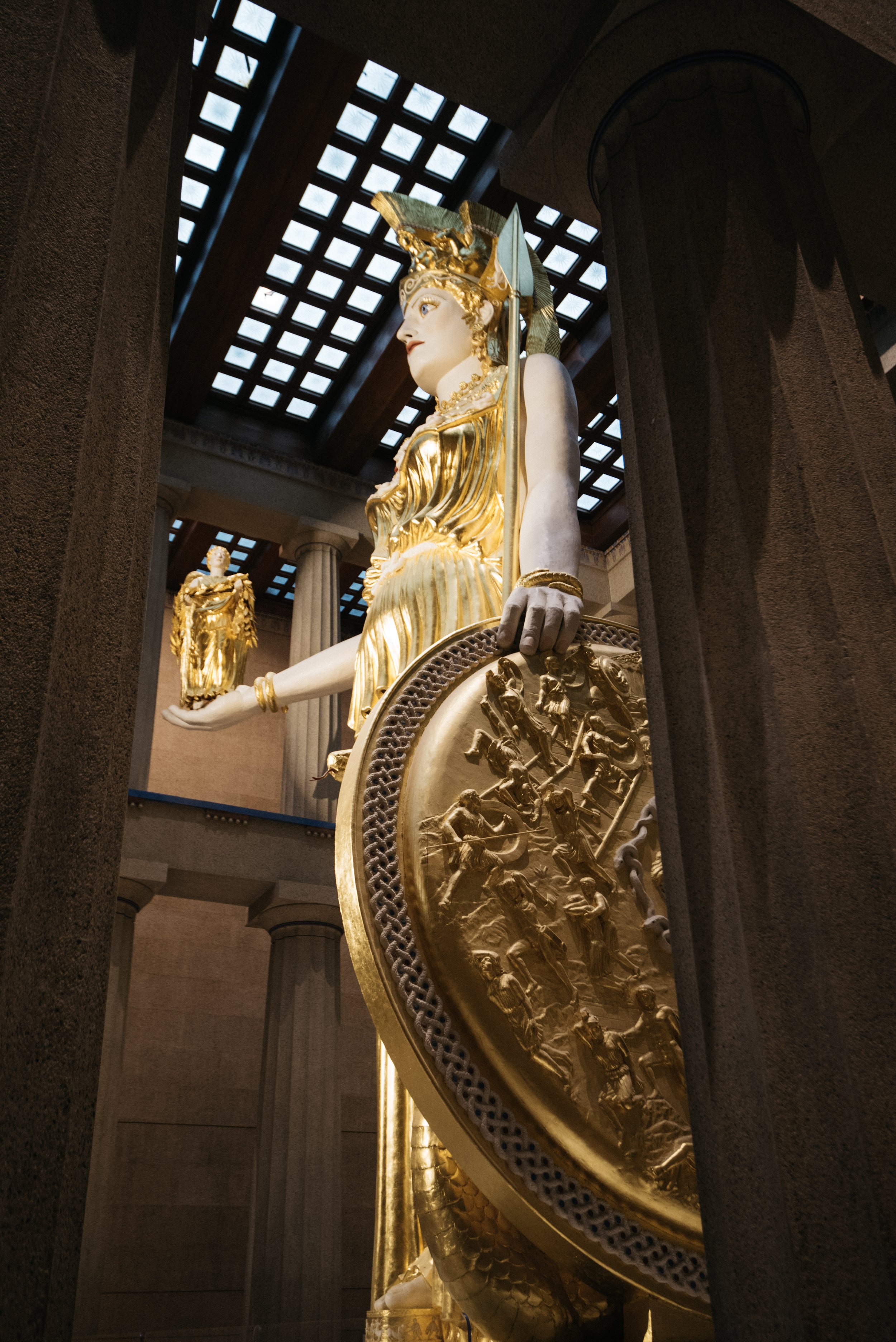
Naos
Learn more about the Naos below!
Para obtener más información, haga clic aquí.
The Statue of Athena Parthenos
The statue of Athena Parthenos was the primary focus of the ancient Parthenon. It was made in the 5th century BCE by the famous sculptor Pheidias. Nothing survives of the ancient sculpture, but there are smaller Roman versions.
The re-creation of the statue by Pheidias was commissioned by Metro Parks in 1982. The work was unveiled on May 20, 1990.
It was made by artist Alan LeQuire, a native Nashvillian. LeQuire’s work is based on the most accurate archaeological data and scholarship of the time, as well as his own aesthetic judgement.
Lenormant Athena, 1st century CE Image courtesy of A.T. Fickle
Alan LeQuire constructing Athena Parthenos, 1980s -Parthenon Collection 2009.0.6
The original statue was constructed using a combination of cast gold and carved ivory. It was assembled in sections onto a wooden armature.
This modern statue was cast in sections and assembled, but with modern materials: a gypsum cement and fiberglass compound attached to a steel framework.
LeQuire’s statue is 41 feet 10 inches (12.7 meters) tall and is covered in 23.75K gold leaf and painted to resemble ivory.
Speculative design of Athena Parthenos, 2002 - Image courtesy of Flyover Zone Inc. All rights reserved.
Athena Parthenon with Polychromy, 2002 -Parthenon Collection
Athena Parthenos panels, 1980s-Parthenon Collection
The Armor of Athena
Athena is the Greek goddess of strategic warfare, wisdom, weaving and the patron goddess of the ancient city-state Athens, Greece.
Her title, Athena Parthenos, refers to her status as a virgin goddess. “The Parthenon” translates into English as “the house of the virgin.”
Born from the head of Zeus, king of the gods, Athena inherited her father’s power. She inherited wisdom from her mother, Metis.
Helmet
The three crests of Athena's helmet are supported by mythological creatures: Pegasus (winged horse) on the left and right and in the center a sphinx (half-women, half-lion).
Peplos
The peplos ( PEP-lows) is a dress made of heavy fabric with large, loose folds at the waist. As goddess of weaving, Athena’s clothing is an important symbol.
Aegis
(EE-giss)
Athena wears a breastplate of armor given to her by Zeus. The center features Medusa, a famous gorgon.
Shield
Athena’s shield protects the snake, indicating her role in defending the people of Athens. On the inside, Olympians battle the Giants. On the exterior, Amazons battle Athenians on the Acropolis.
Serpent
The snake represents Erichthonius, a legendary king of early Athens. It also symbolizes Athenian identity since it was believed, that like the serpent, Athenians came “from the soil of Attica.”
Sandals
Athena’s sandals depict the battle of the Lapiths (a mythical group in northern Greece) and centaurs (half-horse, half-man).
Shield of Athena
Exterior Shield
The shield exterior is a depiction of the battle between Amazons and Athenians. In the center is an image of Medusa, slain by Perseus with the help of Athena.
As an offering of gratitude for her assistance, Perseus gave the gorgon’s head to the goddess.
Interior Shield
Sketch of the shield interior- Image courtesy of Alan LeQuire
On the inside if the shield is a painting of the battle for supremacy between Olympian gods, led by Zeus and the Giants.
Scenes depicting order over chaos are meant to display the power of the city-state of Athens in the middle of the 5th century BCE.
Fast Facts
Weighs nearly 6,000 lbs (2,721 kg)
15 ft wide (4.5 m)
Exterior figures stand out because they are sculpted in high relief
Medusa also appears on Athena’s breastplate
Nike & Pandora
The winged goddess Nike hovers in Athena’s right hand holding a laurel wreath. As the personification of victory, Nike was often associated with Athena. She is 6 feet 4 inches tall.
Nike was symbolic of Athena bringing victory to the Athenians. They believed that Athena protected their city-state and granted them victory over the Persian Empire.
The statue base features Pandora, the first woman in Greek mythology, as the central figure. Her name means “all gifts.”
From left to right, the figures are Helios (in chariot), horses, Hermes, Hera, Zeus (seated), Hebe, Dionysos, the three Horai (hours or seasons- Eunomia, Dike, Eirene). Pandora (on pedestal), Hephaistos, Athena, Poseidon, Artemis, Apollo, Ares, Demeter, Hestia (seated), Eros, Aphrodite, and Selene (on horse).
Want to learn more about the Parthenon and its architecture?
Exterior Architecture Audio Tour
This free exterior architecture tour is available 24/7! From the outside of the Parthenon, follow along with museum experts as they describe the exterior, identify Greek gods and architectural features, and tell the story of the architectural sculpture. We encourage you to listen to each section on your own device, look closely, and follow the prompts to dig deeper and learn more. Sidewalk graphics are on-site to help you get started.
Click the button below to listen to the audio tour.
For more information or find the tour in other languages, click the button below.


















